
Use this graph and chart to monitor your progress. They allow you to see the big picture rather than focusing on one or two weigh-ins.
On the chart, record your weight from your weekly weigh-ins.
On the graph, you’ll plot your weight changes over time. The numbers across the top of the graph represent weeks. The numbers down the left side represent pounds lost or gained. Mark your starting weight at the square indicating 0 pounds and Week 1. Write your weight in pounds on the line next to the number 0. Each block represents one pound. For every subsequent week, mark the appropriate square with a dot. Connect the dots, so you can see your progress.
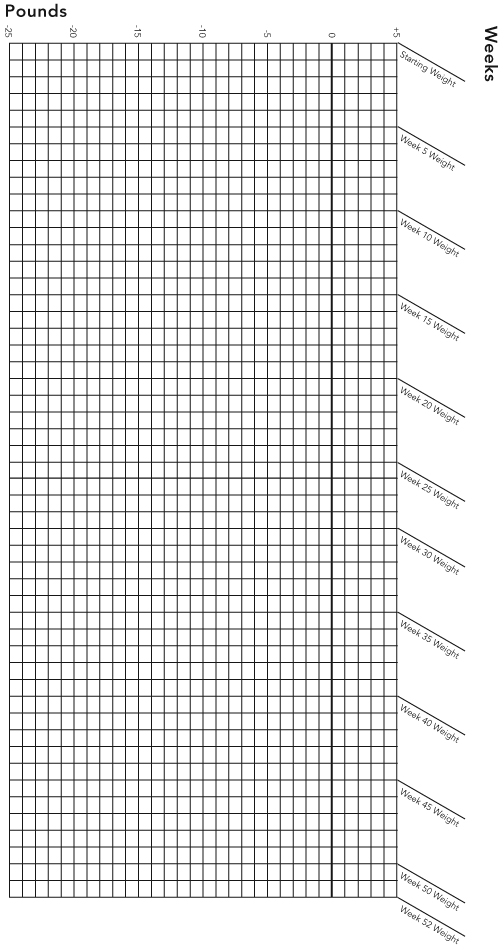
Weight Loss Chart
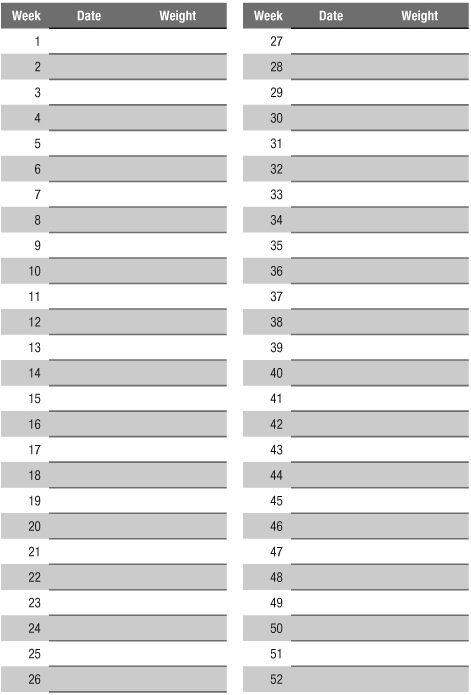
Write your goals in the spaces provided. Check that it meets each of the five SMART goals principles. Then list any steps you must take to assure your success (such as get up early, grocery shop, ask for support, etc.).
S: Specific:
Be specific about what you will do, how you will do it, and where you will do it. If your goal is specific, anyone who reads it will know your plan.
M: Measureable:
Can you measure and objectively report your success?
A: Action-oriented:
Your goal must be stated as a behavior. What action will you take?
R: Realistic:
Can you achieve this goal with the resources you have and with strong effort?
T: Timely:
When will you do this and when will you assess your results?
Goals:
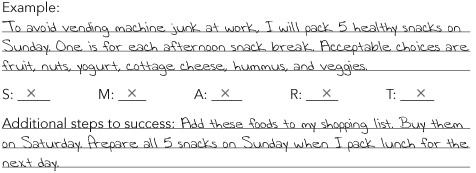
1) ________________________________________________________________
________________________________________________________________
________________________________________________________________
S: ______ M: ______ A: ______ R: ______ T: ______
Additional steps to success: _______________________________________
________________________________________________________________
2) ________________________________________________________________
________________________________________________________________
________________________________________________________________
S: ______ M: ______ A: ______ R: ______ T: ______
Additional steps to success: _______________________________________
________________________________________________________________
3) ________________________________________________________________
________________________________________________________________
________________________________________________________________
S: ______ M: ______ A: ______ R: ______ T: ______
Additional steps to success: _______________________________________
________________________________________________________________
4) ________________________________________________________________
________________________________________________________________
________________________________________________________________
S: ______ M: ______ A: ______ R: ______ T: ______
Additional steps to success: _______________________________________
________________________________________________________________
Make one copy for each day, or create your own in a notebook or on your computer.
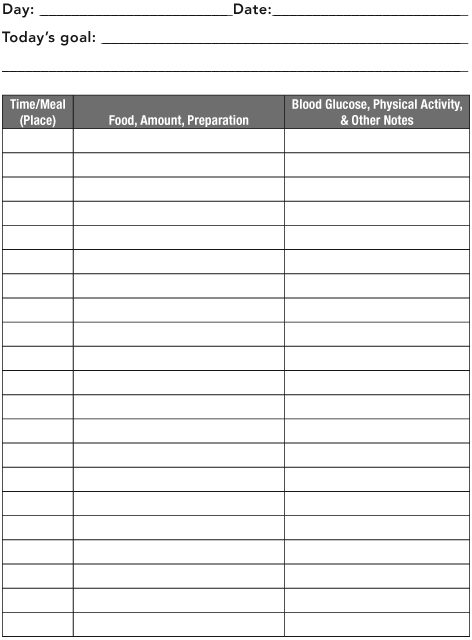
Use this planner to help you plan meals with lots of variety and appropriate portions.
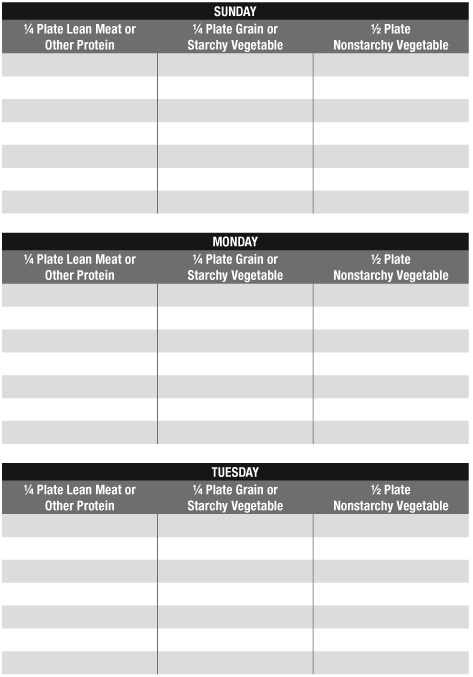
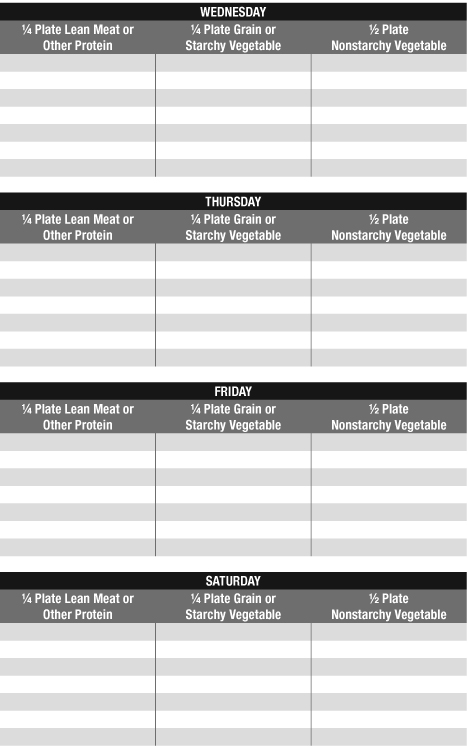
Trouble Times and Places—A Record
Make one copy of this record for each day or create your own version in a notebook or on your computer.
Identify those times of day or those places that make it hard to stick with your eating plan. You might include snacks, all food eaten after 5:00, all food eaten at work, food eaten alone or with others, etc. Pick what is most problematic for you.
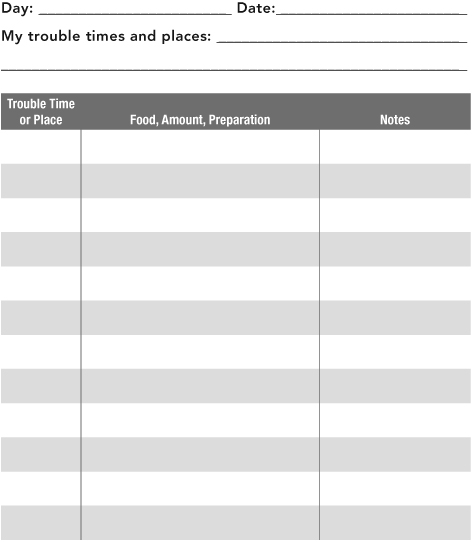
Make one copy of this record for each day, or create your own version in a notebook or on your computer.
Which food goals are the hardest to stick with? If you struggle to limit your soda or juice intake or to eat enough vegetables, record just beverages and vegetables. Write down and review the foods you struggle with most.
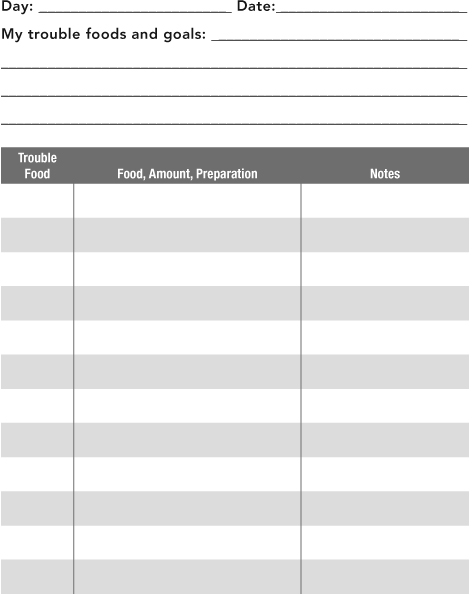
Make one copy of this form for each week, or create your own version in a notebook or on your computer.
Select as many as five goals (for example: eat breakfast, walk at lunchtime). Record your progress on a checklist. This is an objective practice; either you met your goal (ate breakfast or walked at lunchtime) or you did not.
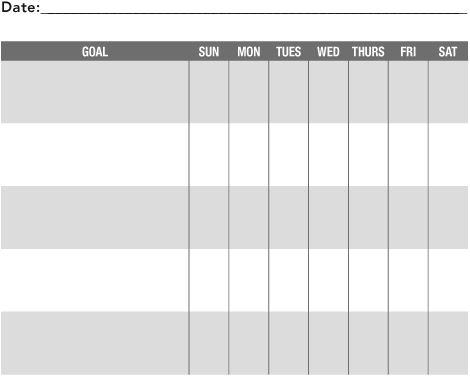
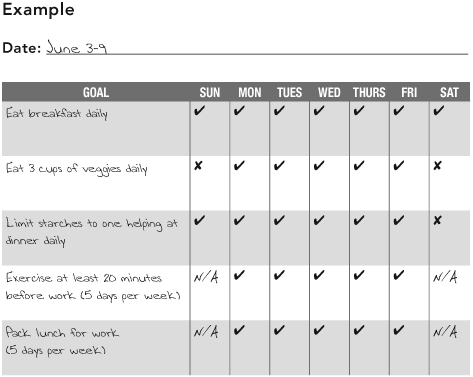
Make one copy of this form for each week, or create your own version in a notebook or on your computer.
At the end of the day, write down a number between 1 and 10 (where 1 is very poor and 10 is excellent) to rate how successfully you have achieved your goals, such as eating appropriate portions or planning your intake ahead of time. This is a subjective score.
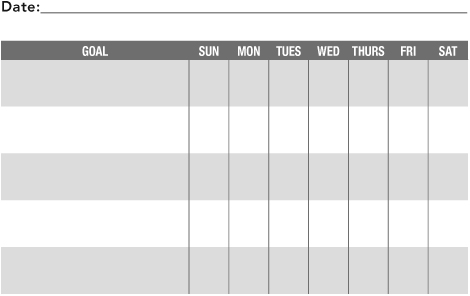
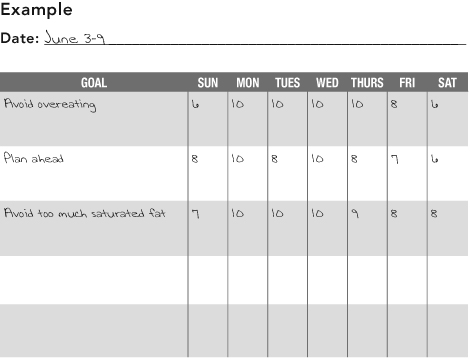
List each new behavior and each benefit you’ve gained by eating better, getting more physical activity, and paying more attention to your health. Write down every positive change you and others have noticed. Here are some examples to get you started.
• Eating smaller portions
• Not skipping meals
• Getting regular physical activity
• Better blood glucose control
• Need less blood pressure medication
• Have more energy
• Feel more confident
• No longer feel terrible remorse when I eat a bit too much
• Sleep better
• Have less knee pain
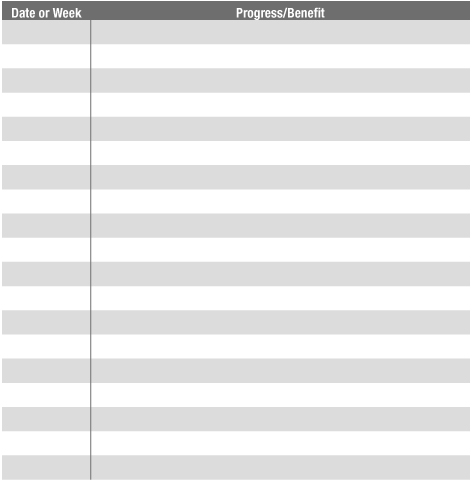
Overcoming Obstacles—The HURDLE Method
One key to overcoming obstacles is to anticipate them before they stand in your way. Get in the habit of using the HURDLE method to identify and prepare for problems.
H: How is your upcoming schedule different? Think about your day, week, or month and look at your calendar. What event is unusual or scheduled for an unusual time?
__________________________________________________________
__________________________________________________________
U: Understand how any of these appointments or obligations could derail you from eating well, exercising, or otherwise get in the way of good self-care. Will something prevent you from eating a meal or getting to your exercise class on time? Will someone else be in charge of your meals or your schedule? How might some activity or problem prevent you from sticking to your food and exercise plan?
__________________________________________________________
__________________________________________________________
R: Record your options. Write down every possible solution, even if it seems silly.
__________________________________________________________
__________________________________________________________
D: Decide on a solution. From the list above, pick an option that is doable and likely to bring you success.
__________________________________________________________
__________________________________________________________
L: List the steps. Record everything you must do to make this solution work. If you must buy something, wake up early, ask for help, or prepare something, write it down.
__________________________________________________________
__________________________________________________________
E: Exercise your choice and Evaluate it. Carry out your selected option. How did it go? Would you do it this way again or make some changes? What did you learn? What will you do differently next time?
__________________________________________________________
__________________________________________________________
Sample Meal Patterns from the Dietary Guidelines for Americans
Remember that there is no one best diet. You and a registered dietitian can create an individualized meal plan that reflects your health, medications, schedule, food preferences, budget, and more. The Dietary Guidelines for Americans, 2010 offers four general meal patterns that illustrate various approaches to healthful eating. You will find them on the following pages. You might also want to investigate the Mediterranean diet, discussed briefly in Week 1, as a fifth approach (visit www.oldwayspt.org or check out a copy of The Mediterranean Diabetes Cookbook by Amy Riolo to learn more). Use these approaches as additional guidance in developing your meal plan.
USDA FOOD PATTERNS
For each food group or subgroup, recommended average daily intake amounts are shown at all calorie levels. Recommended intakes from vegetable and protein subgroups are per week. For more information and tools for application, go to ChooseMyPlate.gov.
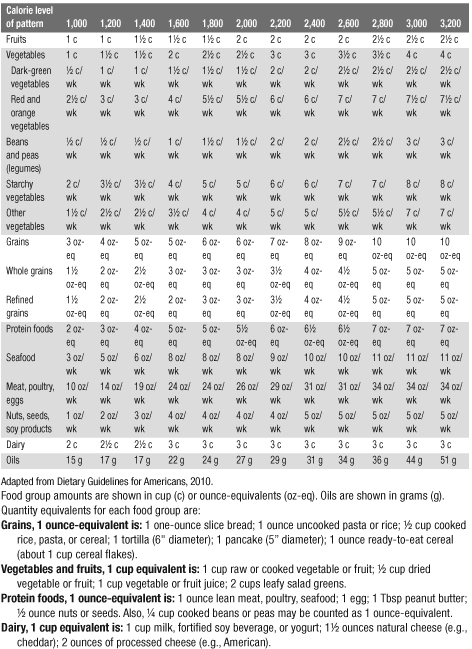
LACTO-OVO VEGETARIAN ADAPTATION OF THE USDA FOOD PATTERNS
For each food group or subgroup, recommended average daily intake amounts are shown at all calorie levels. Recommended intakes from vegetable and protein subgroups are per week. For more information and tools for application, go to ChooseMyPlate.gov.
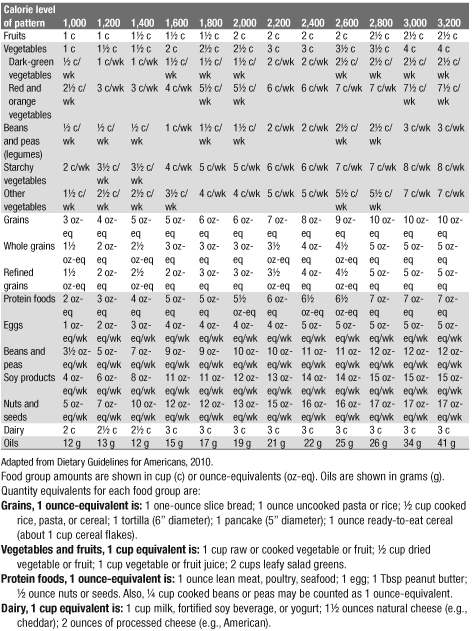
VEGAN ADAPTATION OF THE USDA FOOD PATTERNS
For each food group or subgroup, recommended average daily intake amounts are shown at all calorie levels. Recommended intakes from vegetable and protein subgroups are per week. For more information and tools for application, go to ChooseMyPlate.gov.
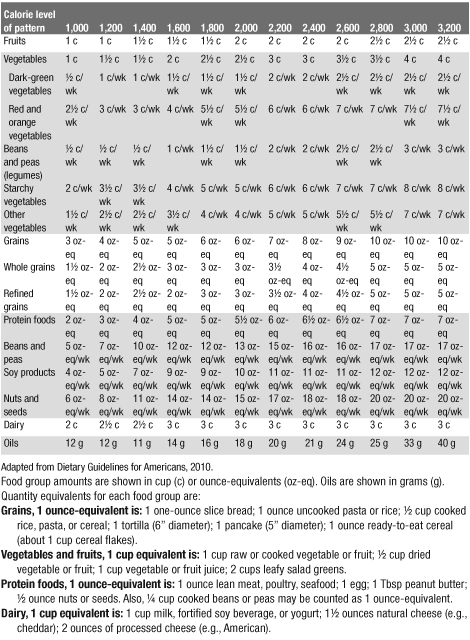
THE DASH (DIETARY APPROACHES TO STOP HYPERTENSION) EATING PLAN
The number of daily servings in a food group varies depending on caloric needs.
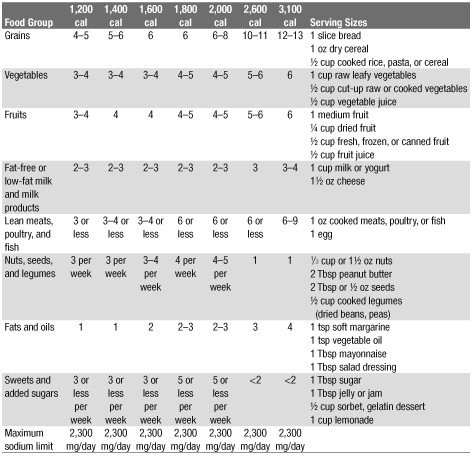
Use these menus as a guide and as inspiration. There is no reason to think that you will like each of the items on these menus or that they include foods that are in season and readily available. Additionally, they may contain more or less carbohydrate than the amount you need, and they may suggest more or fewer snacks than you prefer. There is nothing magical about them. They are here simply to help you learn to plan your meals and expand your usual food choices. Please adapt them at will.
You will notice that a nutritional analysis accompanies each meal and snack. These numbers are ballpark figures only. There is significant nutrient variation in packaged foods from brand to brand and even within brands. Fresh produce varies considerably as well. The nutritional content of an apple, for example, depends on the time of year it was grown and harvested, the amount of sunlight and rain, the soil in which it was grown, and more.
DAY 1
1,300 Calories

DAY 1
1,800 Calories
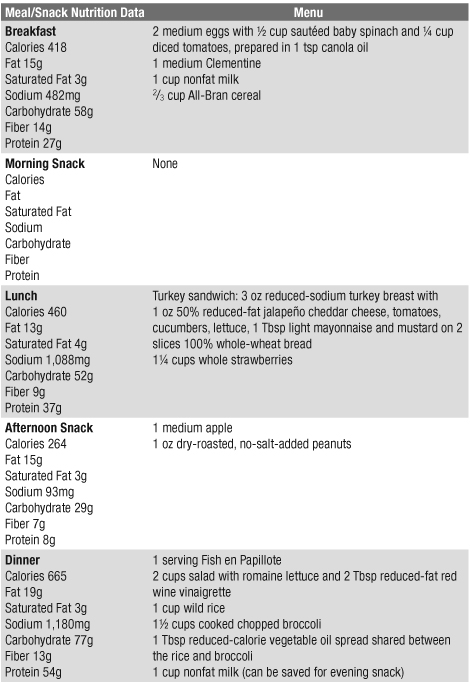
DAY 2
1,300 Calories
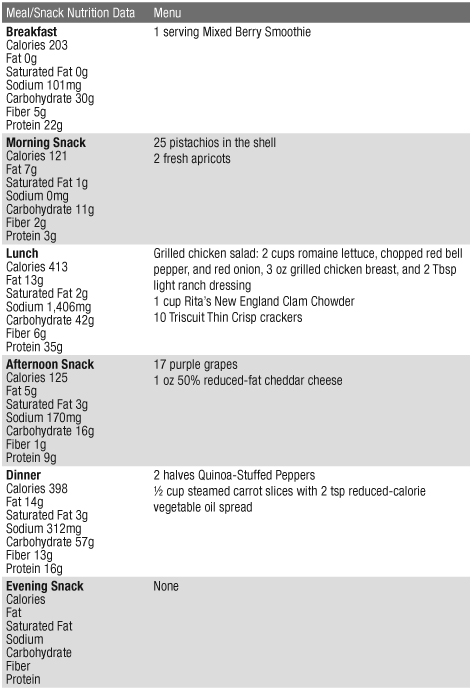
DAY 2
1,800 Calories
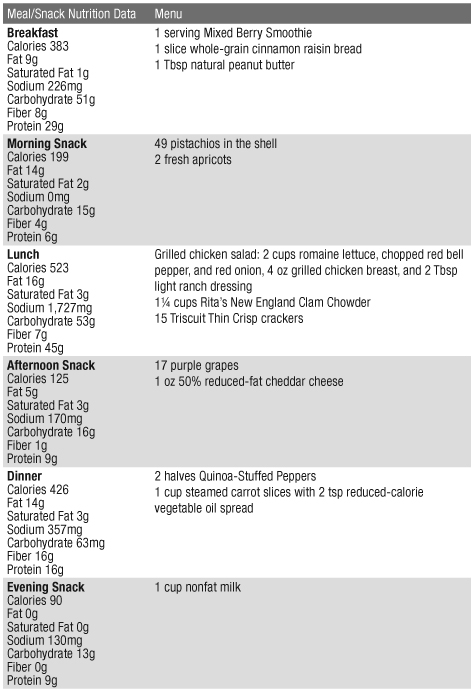
DAY 3
1,300 Calories
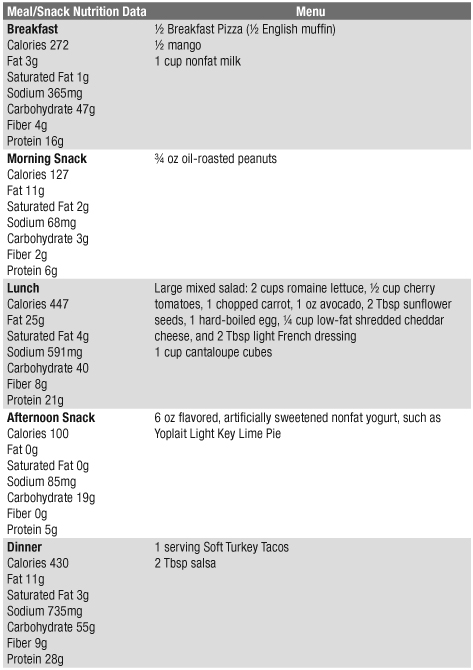
DAY 3
1,800 Calories
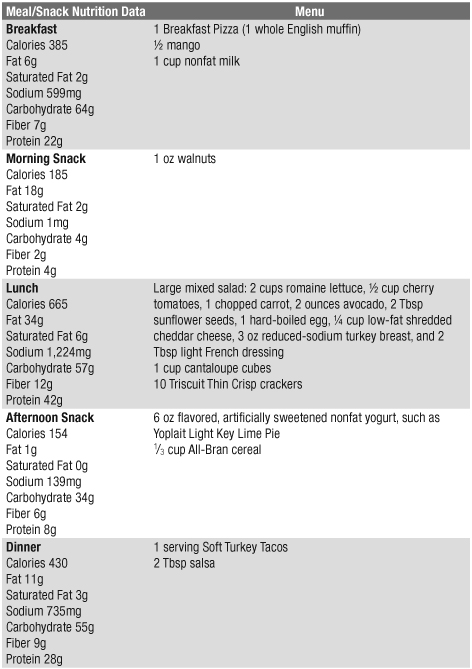
DAY 4
1,300 Calories
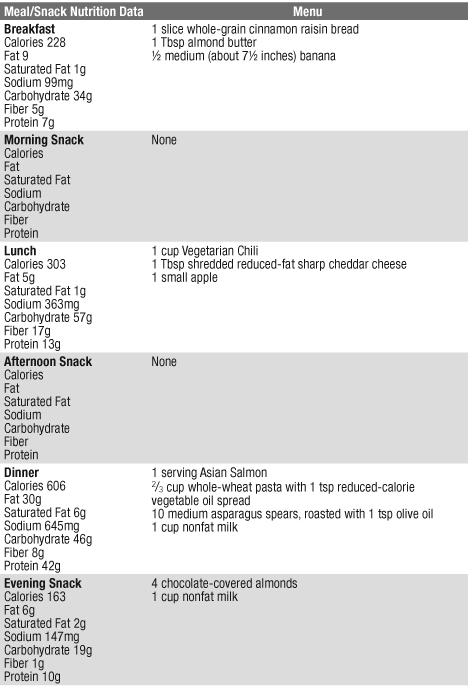
DAY 4
1,800 Calories
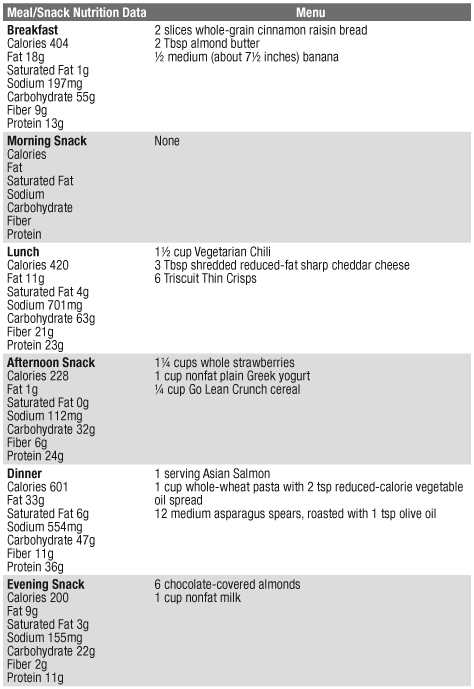
DAY 5
1,300 Calories
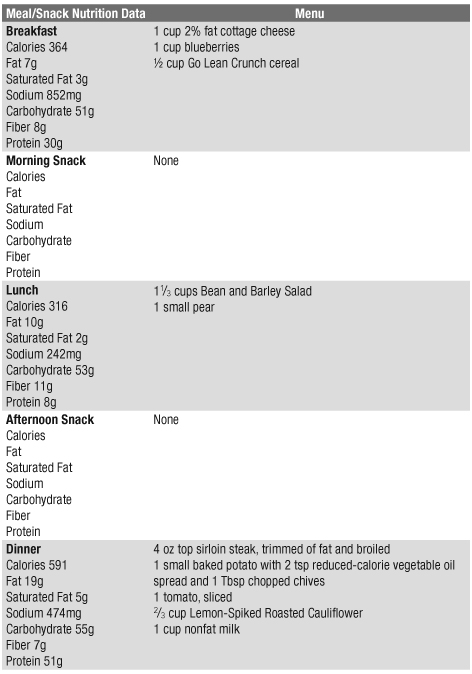
DAY 5
1,800 Calories
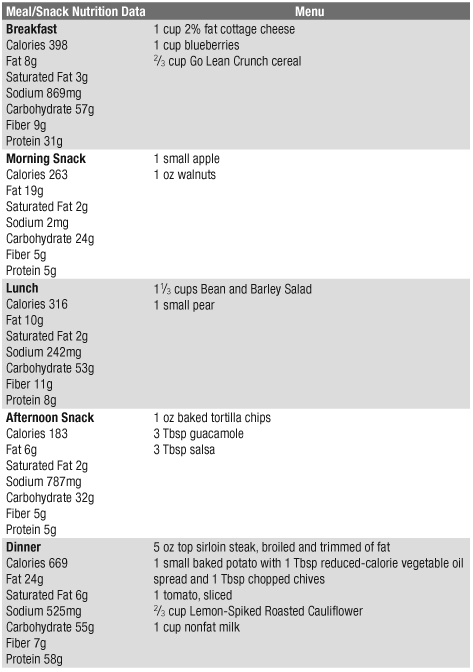
DAY 6
1,300 Calories
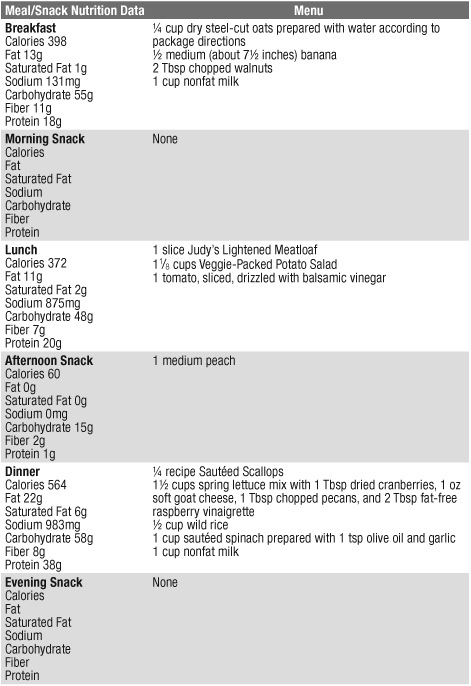
DAY 6
1,800 Calories
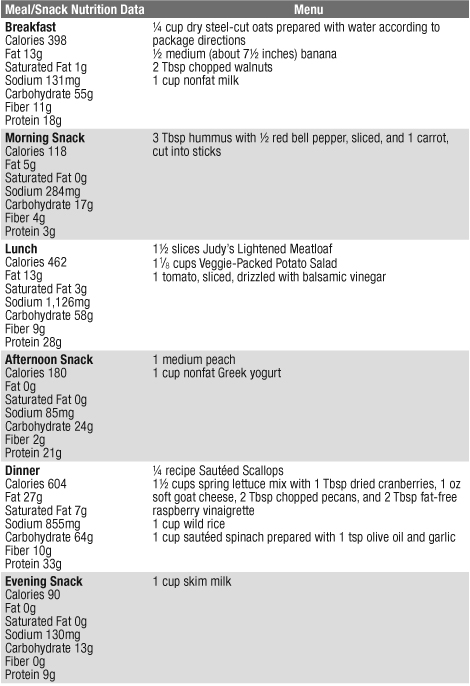
DAY 7
1,300 Calories
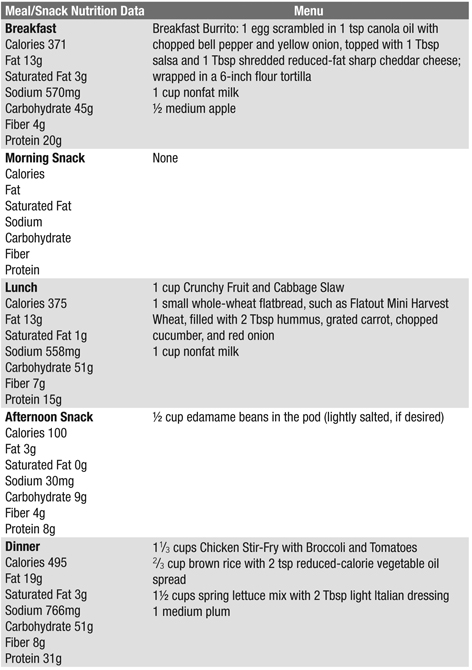
DAY 7
1,800 Calories
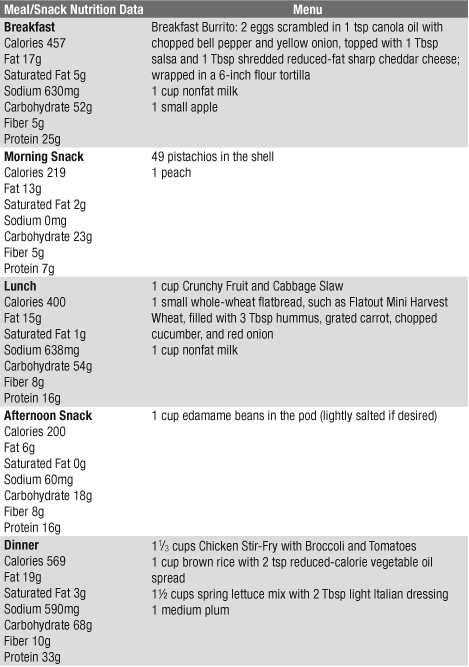
Breakfast
Breakfast Pizza
Mixed Berry Smoothie
Soup
Curry Roasted Cauliflower Soup
Rita’s New England Clam Chowder
Side Dishes
Crunchy Fruit and Cabbage Slaw
Grilled Fresh Mission Figs
Lemon-Spiked Roasted Cauliflower
Lemony Asparagus Spear Salad
Veggie-Packed Potato Salad
Main Dishes
Asian Salmon
Bean and Barley Salad
Chicken Stir-Fry with Broccoli and Tomatoes
Chunky Greek-Style Salad with Tuna
Crispy Chicken Dijon
Fish en Papillote
Judy’s Lightened Meatloaf
Salmon Fillets with Pineapple Salsa
Sautéed Scallops
Soft Turkey Tacos
Quinoa-Stuffed Peppers
Vegetarian Chili